check engine light SKODA OCTAVIA 2009 2.G / (1Z) User Guide
[x] Cancel search | Manufacturer: SKODA, Model Year: 2009, Model line: OCTAVIA, Model: SKODA OCTAVIA 2009 2.G / (1Z)Pages: 304, PDF Size: 19.56 MB
Page 126 of 304
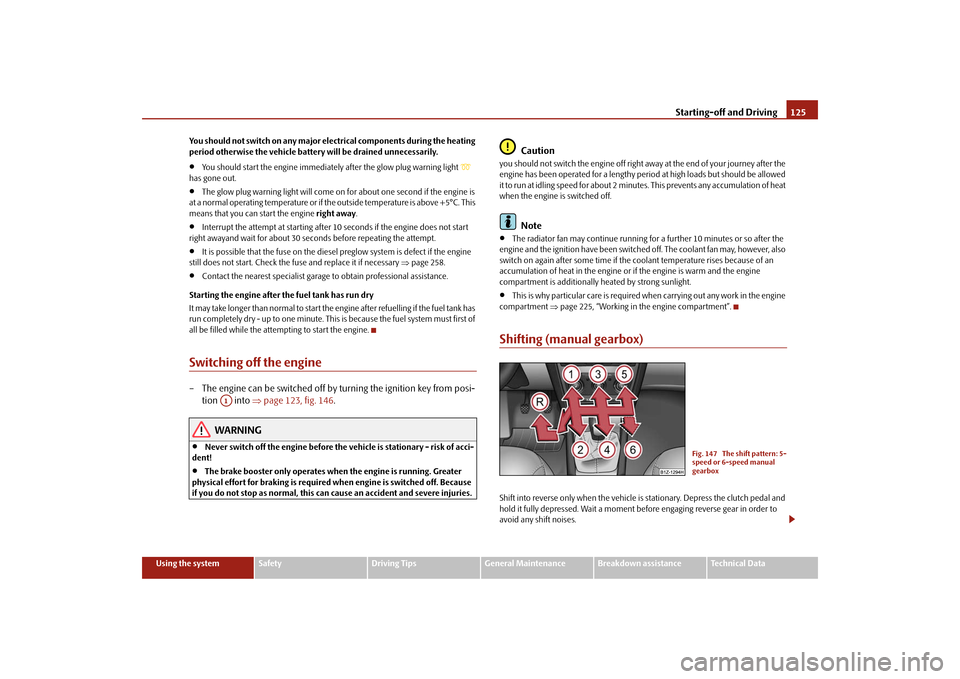
Starting-off and Driving
125
Using the system
Safety
Driving Tips
General Maintenance
Breakdown assistance
Technical Data
You should not switch on any major electrical components during the heating period otherwise the vehicle battery will be drained unnecessarily.•
You should start the engine immediately after the glow plug warning light
has gone out.•
The glow plug warning light will come on for about one second if the engine is
at a normal operating temperature or if th
e outside temperature is above +5°C. This
means that you can start the engine
right away
.
•
Interrupt the attempt at starting after 10 seconds if the engine does not start
right awayand wait for about 30 seconds before repeating the attempt.•
It is possible that the fuse on the diesel
preglow system is defect if the engine
still does not start. Check the fuse and replace it if necessary
⇒page 258.
•
Contact the nearest specialist garage to obtain professional assistance.
Starting the engine after the fuel tank has run dry It may take longer than normal to start the
engine after refuelling if the fuel tank has
run completely dry - up to one minute. This is because the fuel system must first of all be filled while the attempting to start the engine.Switching off the engine– The engine can be switched off by turning the ignition key from posi-
tion into
⇒
page 123, fig. 146
.
WARNING
•
Never switch off the engine before the
vehicle is stationary - risk of acci-
dent!•
The brake booster only operates when the engine is running. Greater
physical effort for braking is required
when engine is switched off. Because
if you do not stop as normal, this can cause an accident and severe injuries.
Caution
you should not switch the engine off right
away at the end of yo
ur journey
after the
engine has been operated for a lengthy peri
od at high loads but should be allowed
it to run at idling speed for about 2 minutes
. This prevents any accumulation of heat
when the engine is switched off.
Note
•
The radiator fan may conti
nue running for a further 10
minutes or
so after the
engine and the ignition have
been switched off. The coolant fan may, however, also
switch on again after some time if the
coolant temperature rises because of an
accumulation of heat in the engine or
if the engine is warm and the engine
compartment is additionally
heated by strong sunlight.
•
This is why particular care is required when carrying out any work in the engine
compartment
⇒page 225, “Working in the engine compartment”.
Shifting (manual gearbox)Shift into reverse only when the vehicle is
stationary. Depress the clutch pedal and
hold it fully depressed. Wait a moment be
fore engaging reverse gear in order to
avoid any shift noises.
A1
Fig. 147 The shift pattern: 5- speed or 6-speed manual gearbox
se0.1.book Page 125 Frida
y, April 10, 2009 3:19 PM
Page 205 of 304
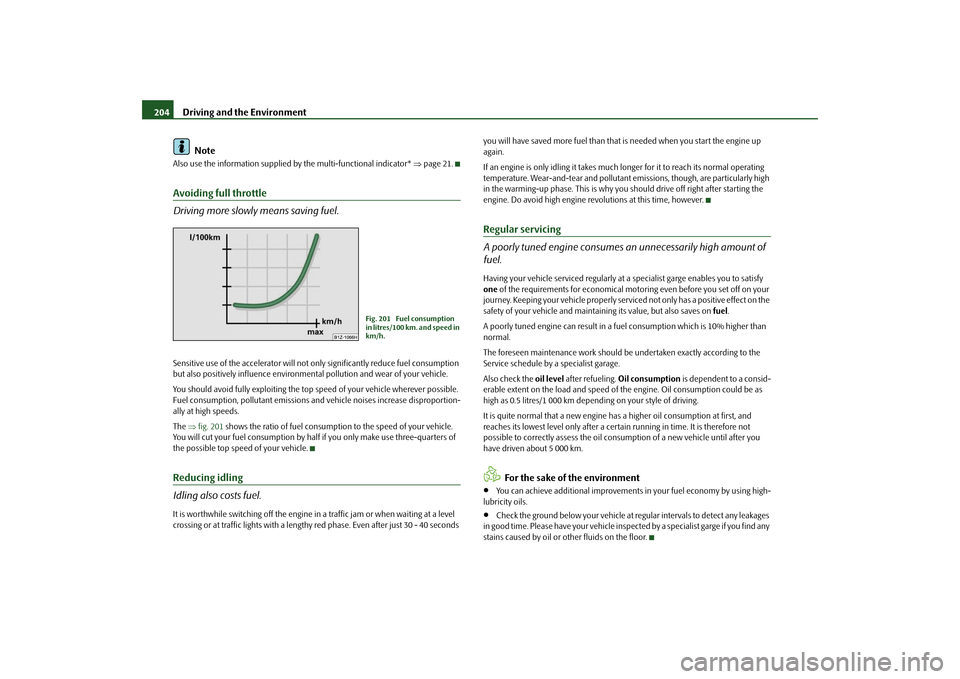
Driving and the Environment
204
Note
Also use the information supplied by the multi-functional indicator*
⇒page 21.
Avoiding full throttle Driving more slowly means saving fuel.Sensitive use of the accelera
tor will not only significantly reduce fuel consumption
but also positively influence environmen
tal pollution and wear of your vehicle.
You should avoid fully exploi
ting the top speed of your vehicle wherever possible.
Fuel consumption, pollutant emissions and vehicle noises increase disproportion- ally at high speeds. The
⇒fig. 201
shows the ratio of fuel consumption to the speed of your vehicle.
You will cut your fuel consumption by half
if you only make use three-quarters of
the possible top speed of your vehicle.Reducing idling Idling also costs fuel.It is worthwhile switching off the engine in
a traffic jam or when waiting at a level
crossing or at traffic lights with a length
y red phase. Even after just 30 - 40 seconds
you will have saved more fuel than that
is needed when you start the engine up
again. If an engine is only idling it takes much
longer for it to reach its normal operating
temperature. Wear-and-tear and pollutant emissions, though, are particularly high in the warming-up phase. This is why you
should drive off right after starting the
engine. Do avoid high engine re
volutions at this time, however.
Regular servicing A poorly tuned engine consumes an unnecessarily high amount of fuel.Having your vehicle serviced regularly at a specialist garge enables you to satisfy one
of the requirements for economical moto
ring even before you set off on your
journey. Keeping your vehicle properly servic
ed not only has a positive effect on the
safety of your vehicle and maintaining its value, but also saves on
fuel
.
A poorly tuned engine can result in a fu
el consumption which is 10% higher than
normal. The foreseen maintenance work should be undertaken exactly according to the Service schedule by a specialist garage. Also check the
oil level
after refueling.
Oil consumption
is dependent to a consid-
erable extent on the load and speed of
the engine. Oil consum
ption could be as
high as 0.5 litres/1 000 km depending on your style of driving. It is quite normal that a new engine ha
s a higher oil consumption at first, and
reaches its lowest level only
after a certain running in
time. It is therefore not
possible to correctly assess the oil cons
umption of a new vehicle until after you
have driven about 5 000 km.
For the sake of the environment
•
You can achieve additional improvements
in your fuel economy by using high-
lubricity oils.•
Check the ground below your vehicle at re
gular intervals to detect any leakages
in good time. Please have yo
ur vehicle inspected by a specialist garge if you find any
stains caused by oil or
other fluids on the floor.
Fig. 201 Fuel consumption in litres/100 km. and speed in km/h.
se0.1.book Page 204 Frida
y, April 10, 2009 3:19 PM
Page 207 of 304

Driving and the Environment
206
Keeping a log of your fuel consumptionIf you really wish to ke
ep a close check on your
fuel consumption
, it is best to enter
the figures in a logbook. This does not take
much time but is a very worthwhile exer-
cise. It enables you to detect any change
(positive and negative) at an early stage
and to take any appropriate action. If you find that your fuel
consumption is too high, you sh
ould reflect on how, where
and in what conditions you have driven
the vehicle since you last refuelled.
Environmental compatibilityEnvironmental protection has played a majo
r role in the design, selection of mate-
rials and manufacture of your new Škoda.
Particular emphasis
has been paid to a
number of aspects, including: Design measures•
Joints designed to
be easily detached.
•
Simplified disassembly due to the modular structure system.
•
Improved purity of differ
ent classes of materials.
•
Identification of all plastic parts in
accordance with VDA Recommendation°260.
•
Reduced fuel consumption
and exhaust emission CO
2.
•
Minimum fuel leakage during accidents.
•
Reduced noise.
Choice of materials•
Extensive use of recyclable material.
•
Air conditioning filled wi
th CFC-free refrigerant.
•
No cadmium.
•
No asbestos.
•
Reduction in the “vaporisation” of plastics.
Manufacture•
Solvent-free cavity protection.
•
Solvent-free protection of the vehicle for transportation from the production
plant to the customer.•
The use of solvent-free adhesives.
•
No CFCs used in the production process.
•
Without use of mercury.
•
Use of water-soluble paints.
Motoring abroadGeneral Other circumstances may exist abroad.It is also possible, in certain countries, that the Škoda Service Partner network is limited or has not been established yet.
This is the reason why obtaining certain
spare parts may be somewhat complicate
d and specialist garage personnel may
o n l y b e a b l e t o m a ke l i m i te d re p a i rs . Š ko d a A u to i n t h e C z e c h R e pu b l i c a n d re l e v a n t importers are happy to provide information
about technical aspects of the vehicle,
required maintenance work and possibilities for getting repairs done.Unleaded petrolA vehicle fitted with a petrol engine must always be refuelled with unleaded petrol ⇒ page 202. The automobile associations can provide you with information regarding the locations of filling stations which offer unleaded petrol.HeadlightThe low beam of your headlights is set asym
metrically. It illuminates the side of the
road on which you are driving to a greater
extent. If you drive abroad on the other
side of the road, you wi
ll dazzle oncoming traffic.
In order to prevent the dazzling of oncoming
traffic, it is necessary that an adjust-
ment of the headlights is carried out by
your authorised Škoda Service Partner.
se0.1.book Page 206 Frida
y, April 10, 2009 3:19 PM
Page 210 of 304
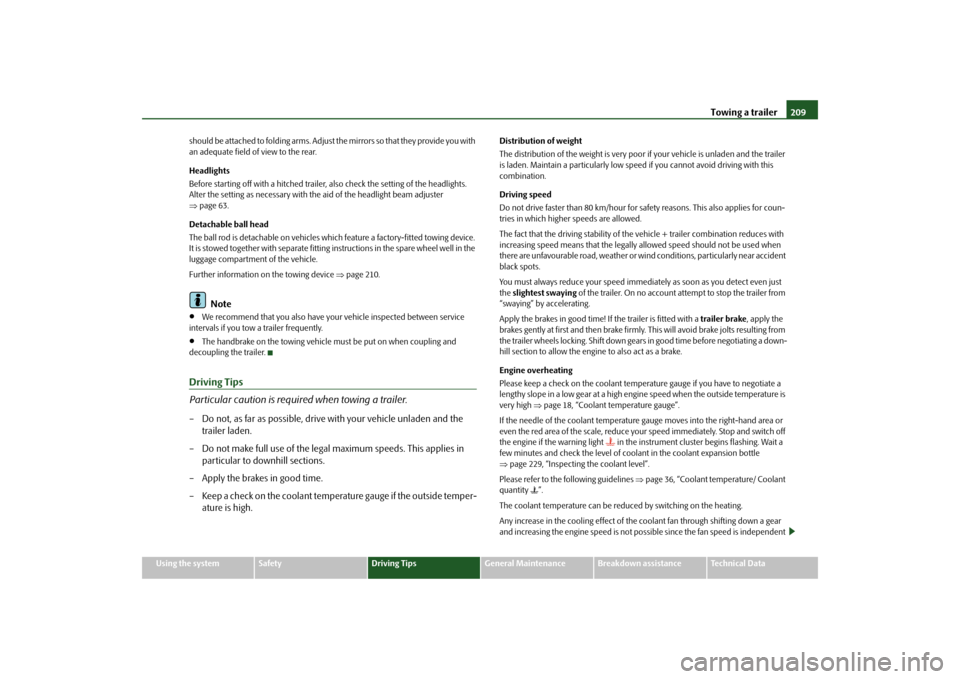
Towing a trailer
209
Using the system
Safety
Driving Tips
General Maintenance
Breakdown assistance
Technical Data
should be attached to folding arms. Adjust
the mirrors so that they provide you with
an adequate field of view to the rear. Headlights Before starting off with a hitched trailer, also check the setting of the headlights. Alter the setting as necessary with th
e aid of the headlight beam adjuster
⇒ page 63. Detachable ball head The ball rod is detachable on vehicles which feature a factory-fitted towing device. It is stowed together with separate fitting instructions in the spare wheel well in the luggage compartment of the vehicle. Further information on the towing device
⇒page 210.
Note
•
We recommend that you also have yo
ur vehicle inspected between service
intervals if you tow a trailer frequently.•
The handbrake on the towing vehicle
must be put on when coupling and
decoupling the trailer.Driving Tips Particular caution is required when towing a trailer.– Do not, as far as possible, drive
with your vehicle unladen and the
trailer laden.
– Do not make full use of the legal maximum speeds. This applies in
particular to downhill sections.
– Apply the brakes in good time.– Keep a check on the coolant temper
ature gauge if the outside temper-
ature is high.
Distribution of weight The distribution of the weight is very poor
if your vehicle is
unladen and the trailer
is laden. Maintain a particularly low speed if you cannot avoid driving with this combination. Driving speed Do not drive faster than 80 km/hour for safety reasons. This also applies for coun- tries in which higher speeds are allowed. The fact that the driving stability of the vehicle + trailer combination reduces with increasing speed means that the legally allowed speed should not be used when there are unfavourable road, weather or wind
conditions, particul
arly near accident
black spots. You must always reduce your speed immedi
ately as soon as you detect even just
the
slightest swaying
of the trailer. On no account attempt to stop the trailer from
“swaying” by
accelerating.
Apply the brakes in good time! If the trailer is fitted with a
trailer brake
, apply the
brakes gently at first and then brake firmly
. This will avoid brake jolts resulting from
the trailer wheels locking. Shift down gears
in good time before negotiating a down-
hill section to allow the engine to also act as a brake. Engine overheating Please keep a check on the coolant temperature gauge if you have to negotiate a lengthy slope in a low gear at a high engine speed when the outside temperature is very high
⇒page 18, “Coolant temperature gauge”.
If the needle of the coolant temperature gauge moves into the right-hand area or even the red area of the scale, reduce yo
ur speed immediately. Stop and switch off
the engine if the warning light
in the instrument cluste
r begins flashing. Wait a
few minutes and check the level of coolant in the coolant expansion bottle ⇒ page 229, “Inspecting the coolant level”. Please refer to the following guidelines
⇒page 36, “Coolant temperature/ Coolant
quantity
”.
The coolant temperature can be reduced by switching on the heating.Any increase in the cooling effect of the coolant fan through shifting down a gear and increasing the engine speed is not possible since the fan speed is independent
se0.1.book Page 209 Frida
y, April 10, 2009 3:19 PM
Page 226 of 304

Inspecting and replenishing
225
Using the system
Safety
Driving Tips
General Maintenance
Breakdown assistance
Technical Data
– Pulling on the locking lever
⇒
page 224, fig. 208
will unlock the
bonnet fully.
– Grip with the hand under
the radiator grille and lift up the bonnet.
– Take the bonnet support out of its holder and set it in the opening
designed for it
⇒
page 224, fig. 209
.
Closing the bonnet – Lift the bonnet slightly and unhook the bonnet support. Press the
bonnet support into the hold
er designed to hold it.
– Allow the bonnet to drop from a height of about 20 cm into the lock -
bonnet
do not press down on it
!
WARNING
•
Never open the bonnet if you see that steam or coolant is flowing out of
the engine compartment - risk of scaldi
ng! Wait long enough until the steam
or coolant has stopped escaping.•
For safety reasons, the bonnet must always be properly closed when
driving. One should therefore check that
the lock has in fact engaged prop-
erly after closing the bonnet.•
Stop your vehicle immediately while driv
ing if you notice that the lock is
not properly engaged and close the bonne
t properly - risk of an accident!
Caution
Never open the bonnet using the locking lever - danger of causing damage.Working in the engine compartment Particular care is required when carrying out any work in the engine compartment!There is a risk of injuries, scalding,
accidents and fire when working in the
engine compartment, e.g. inspecting and replenishing oil and other fluids. For
this reason, it is essential to comply with the warning instructions stated below and with the general applicable
rules of safety. The engine compart-
ment of your car is a hazardous area
⇒
.
WARNING
•
Never open the bonnet if you see that steam or coolant is flowing out of
the engine compartment - risk of scaldi
ng! Wait long enough until the steam
or coolant has stopped escaping.•
Switch off the engine and pull out the ignition key.
•
Apply the handbrake firmly.
•
If your vehicle is fitted with a ma
nual gearbox, move the gearshift lever
into Neutral, or if it is fitted with
automatic gearbox, move the selector lever
into position P.•
Allow the engine to cool down.
•
Keep children clear of the engine compartment.
•
Never spill oil and other fluids over the hot engine. Such fluids (e.g. the
antifreeze contained in the coolant) may ignite!•
Avoid short circuits in the electrical system - particularly on the battery.
•
Never place your hand into the radiator fan as long as the engine is still
warm. The fan might suddenly start running!•
Never open the cap of the coolant expa
nsion bottle as long
as the engine
is still warm. The cooling system is pressurized!•
Cover over the cap of the coolant expansion reservoir with a large cloth
when opening it as protection for your
face, hands and arms from hot steam
or hot coolant.•
Do not let objects, such as e.g cleani
ng cloth or tools lie in the engine
compartment.•
If you wish to work under the vehicle, you must secure the vehicle from
rolling away and support it with suitab
le supporting blocks
; the lifting jack*
is not sufficient for this - risk of injury!•
In cases where it be necessary to carry out inspection work when the
engine is running there is an additional risk from rotating parts (e.g. the V-
se0.1.book Page 225 Frida
y, April 10, 2009 3:19 PM
Page 228 of 304

Inspecting and replenishing
227
Using the system
Safety
Driving Tips
General Maintenance
Breakdown assistance
Technical Data
Engine oilCheck engine oil level The dipstick indicates the level of oil in the engine.Checking the oil level – Ensure that the vehicle is positioned on a level surface. – Switch the engine off. – Open the bonnet
⇒
in “Working in the engine compartment” on
page 225.
– Wait a few minutes and pull out the oil dipstick.– Wipe off the dipstick with a clea
n cloth and insert it again fully.
– Then withdraw the dipstick ag
ain and read off the oil level.
Oil level within range – You must
not
top up the oil.
Oil level within range –You
may
top up the oil. It is possible that the oil level may then be
within range after doing this.
Oil level within range –You
must
top up the oil
⇒
page 228. It is sufficient, once this is done,
to keep the oil level within range .
It is normal for the engine to consume oi
l. The oil consumption may be as much as
0.5 l/1 000 km depending on your style of driving and the conditions under which you operate your vehicle. The oil consumpt
ion may be slightly higher than this
during the first 5 000 kilometres. One should therefore check the oil level at regular intervals, preferably every time after the fuel tank is filled or after driving for long stretches. We recommend maintaining the oil level within the range -
but not above this
,
if the engine has been operating at hi
gh loads, for example during a lengthy
motorway trip during the summer months,
towing a trailer or negotiating a high
mountain pass. The warning light in the instrument cluster* will indicate
⇒page 35, “Engine oil
pressure
” whether the oil level is too low. In this case, check the oil level as soon
as possible. Top up with an appropriate quantity of oil.
Caution
•
The oil level must on no account ex
tend beyond the range . Danger of
damaging the cata
lytic converter.
•
Do not continue your journey
if for some reason it is not possible under the
conditions prev
ailing to top up with oil.
Switch of the engine and contact
and
obtain professional assistance from a specialist garage.
Note
Engine oil specifications
⇒page 271, “Technical Data”.
Fig. 211 Dipstick
AA
AB
AA
AC
AB
AA
AA
se0.1.book Page 227 Frida
y, April 10, 2009 3:19 PM
Page 230 of 304
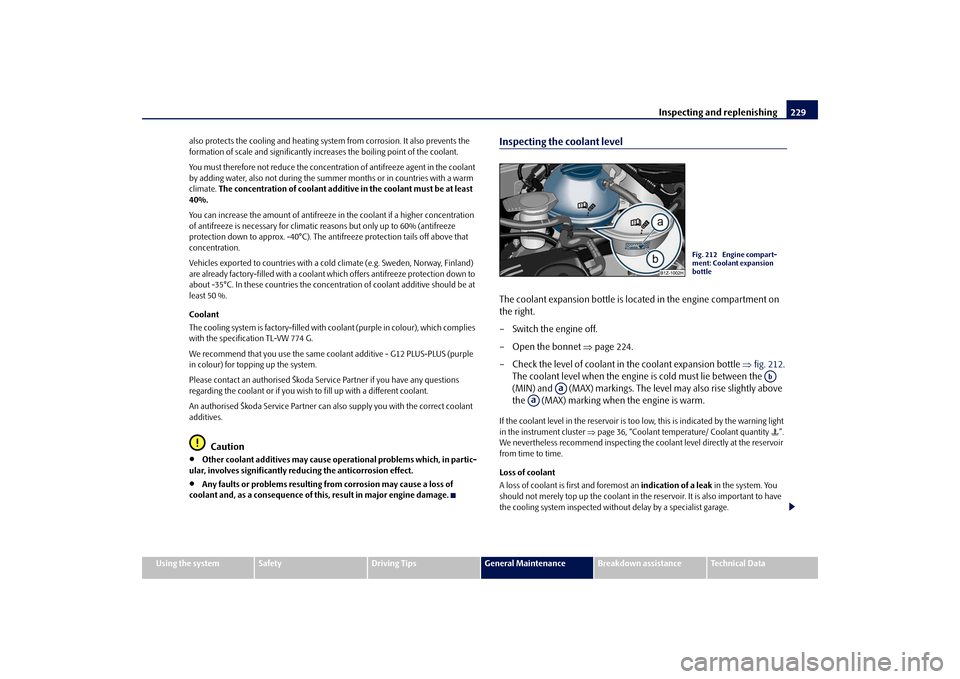
Inspecting and replenishing
229
Using the system
Safety
Driving Tips
General Maintenance
Breakdown assistance
Technical Data
also protects the cooling and heating system from corrosion. It also prevents the formation of scale and significantly increases the boiling point of the coolant. You must therefore not reduce the concentr
ation of antifreeze agent in the coolant
by adding water, also not during the summ
er months or in countries with a warm
climate.
The concentration of coolant additive in the coolant must be at least
40%. You can increase the amount of antifreeze
in the coolant if a higher concentration
of antifreeze is necessary for climatic
reasons but only up to 60% (antifreeze
protection down to approx. -40°C). The an
tifreeze protection tails off above that
concentration. Vehicles exported to countries with a co
ld climate (e.g. Sweden, Norway, Finland)
are already factory-filled with a coolant wh
ich offers antifreeze protection down to
about -35°C. In these countries the concentr
ation of coolant additive should be at
least 50 %. Coolant The cooling system is factory-filled with co
olant (purple in colour), which complies
with the specification TL-VW 774 G. We recommend that you use the same c
oolant additive - G12 PLUS-PLUS (purple
in colour) for toppi
ng up the system.
Please contact an authorised Škoda Service Partner if you have any questions regarding the coolant or if you wish to fill up with a different coolant. An authorised Škoda Service Partner can al
so supply you with the correct coolant
additives.
Caution
•
Other coolant additives may cause operational problems which, in partic-
ular, involves significantly redu
cing the anticorrosion effect.
•
Any faults or problems resulting from corrosion may cause a loss of
coolant and, as a consequence of th
is, result in major engine damage.
Inspecting the coolant levelThe coolant expansion bottle is loca
ted in the engine compartment on
the right. – Switch the engine off. – Open the bonnet
⇒
page 224.
– Check the level of coolant in the coolant expansion bottle
⇒
fig. 212
.
The coolant level when the engine is cold must lie between the (MIN) and (MAX) markings. The level may also rise slightly above the (MAX) marking when the engine is warm.
If the coolant level in the reservoir is too low, this is indicated by the warning light in the instrument cluster
⇒page 36, “Coolant temperat
ure/ Coolant quantity
”.
We nevertheless recommend in
specting the coolant level directly at the reservoir
from time to time. Loss of coolant A loss of coolant is first and foremost an
indication of a leak
in the system. You
should not merely top up the coolant in the
reservoir. It is also important to have
the cooling system inspected without delay by a specialist garage.
Fig. 212 Engine compart- ment: Coolant expansion bottle
Ab
Aa
Aa
se0.1.book Page 229 Frida
y, April 10, 2009 3:19 PM
Page 237 of 304
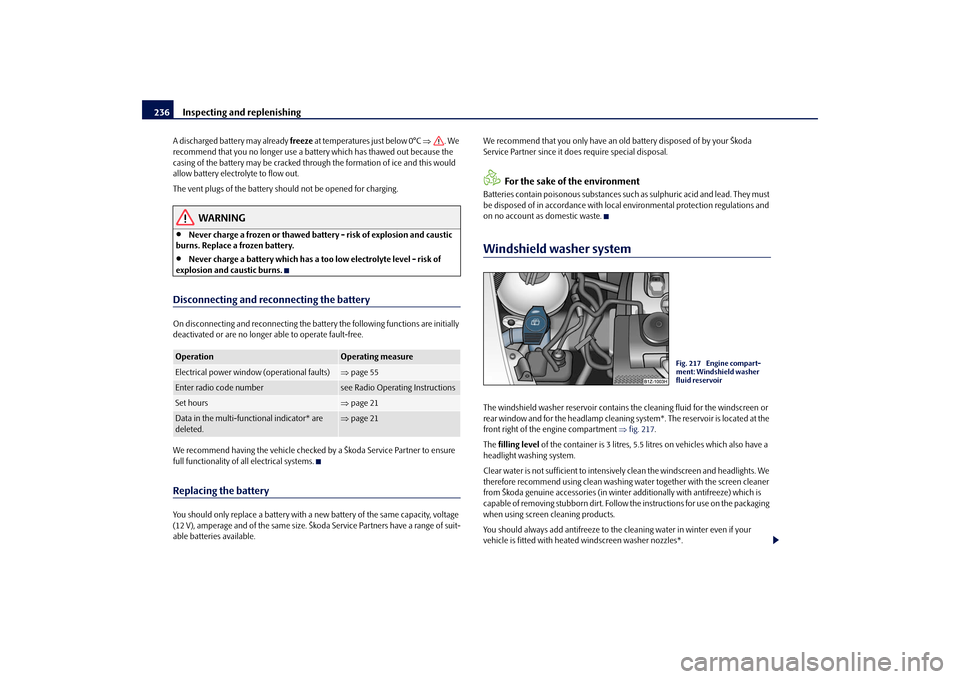
Inspecting and replenishing
236
A discharged battery may already
freeze
at temperatures just below 0°C
⇒
. We
recommend that you no longer use a ba
ttery which has thawed out because the
casing of the battery may be cracked thro
ugh the formation of ice and this would
allow battery electrolyte to flow out. The vent plugs of the battery should not be opened for charging.
WARNING
•
Never charge a frozen or thawed battery - risk of explosion and caustic
burns. Replace a frozen battery.•
Never charge a battery which has a to
o low electrolyte level - risk of
explosion and caustic burns.Disconnecting and reconnecting the batteryOn disconnecting and reconnecting the batte
ry the following functions are initially
deactivated or are no longer able to operate fault-free. We recommend having the vehicle checked
by a Škoda Service Partner to ensure
full functionality of all electrical systems.Replacing the batteryYou should only replace a battery with a
new battery of the same capacity, voltage
(12 V), amperage and of the same size. Škoda Service Partners have a range of suit- able batteries available.
We recommend that you only have an ol
d battery disposed of by your Škoda
Service Partner since it does require special disposal.
For the sake of the environment
Batteries contain poisonous substances such
as sulphuric acid and lead. They must
be disposed of in accordance with loca
l environmental protection regulations and
on no account as domestic waste.Windshield washer systemThe windshield washer reserv
oir contains the cl
eaning fluid for th
e windscreen or
rear window and for the headlamp cleaning system*. The reservoir is located at the front right of the engine compartment
⇒fig. 217
.
The
filling level
of the container is 3 litres, 5.5 li
tres on vehicles which also have a
headlight washing system. Clear water is not sufficient to intensively clean the windscreen and headlights. We therefore recommend using clean washing water together with the screen cleaner from Škoda genuine accessories (in winter
additionally with antifreeze) which is
capable of removing stubborn
dirt. Follow the instructio
ns for use on the packaging
when using screen cleaning products. You should always add antifreeze to the
cleaning water in winter even if your
vehicle is fitted with heated
windscreen washer nozzles*.
Operation
Operating measure
Electrical power window (operational faults)
⇒page 55
Enter radio code number
see Radio Operating Instructions
Set hours
⇒page 21
Data in the multi-functional indicator* are deleted.
⇒ page 21
Fig. 217 Engine compart- ment: Windshield washer fluid reservoir
se0.1.book Page 236 Frida
y, April 10, 2009 3:19 PM
Page 249 of 304
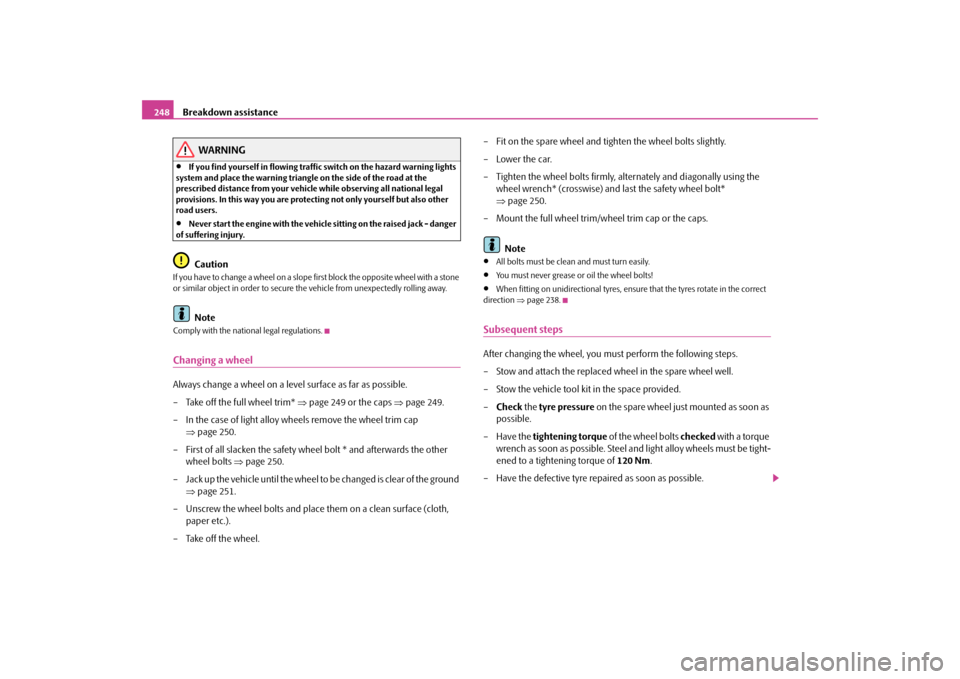
Breakdown assistance
248
WARNING
•
If you find yourself in flowing traffic switch on the hazard warning lights
system and place the warning triangle
on the side of the road at the
prescribed distance from your vehicl
e while observing all national legal
provisions. In this way you are protecting not only yourself but also other road users.•
Never start the engine with the vehicle
sitting on the raised jack - danger
of suffering injury.
Caution
If you have to change a wheel on a slope
first block the opposite wheel with a stone
or similar object in order to secure th
e vehicle from unexpectedly rolling away.
Note
Comply with the national legal regulations.Changing a wheelAlways change a wheel on a level surface as far as possible. – Take off the full wheel trim*
⇒
page 249 or the caps
⇒
page 249.
– In the case of light alloy wheels remove the wheel trim cap
⇒
page 250.
– First of all slacken the safety wh
eel bolt * and afterwards the other
wheel bolts
⇒
page 250.
– Jack up the vehicle until the wheel to
be changed is clear of the ground
⇒
page 251.
– Unscrew the wheel bolts and place them on a clean surface (cloth,
paper etc.).
– Take off the wheel.
– Fit on the spare wheel and tighten the wheel bolts slightly. – Lower the car. – Tighten the wheel bolts firmly, al
ternately and diagonally using the
wheel wrench* (crosswise) and last the safety wheel bolt* ⇒
page 250.
– Mount the full wheel trim/w
heel trim cap or the caps.
Note
•
All bolts must be clean
and must turn easily.
•
You must never grease or oil the wheel bolts!
•
When fitting on unidirectional tyres, ensure that the tyres rotate in the correct
direction
⇒page 238.
Subsequent stepsAfter changing the wheel, you must perform the following steps. – Stow and attach the replaced wheel in the spare wheel well. – Stow the vehicle tool kit in the space provided. –
Check
the
tyre pressure
on the spare wheel just mounted as soon as
possible.
– Have the
tightening torque
of the wheel bolts
checked
with a torque
wrench as soon as possible. Steel and light alloy wheels must be tight-ened to a tightening torque of
120 Nm
.
– Have the defective tyre repaired as soon as possible.
se0.1.book Page 248 Frida
y, April 10, 2009 3:19 PM
Page 253 of 304
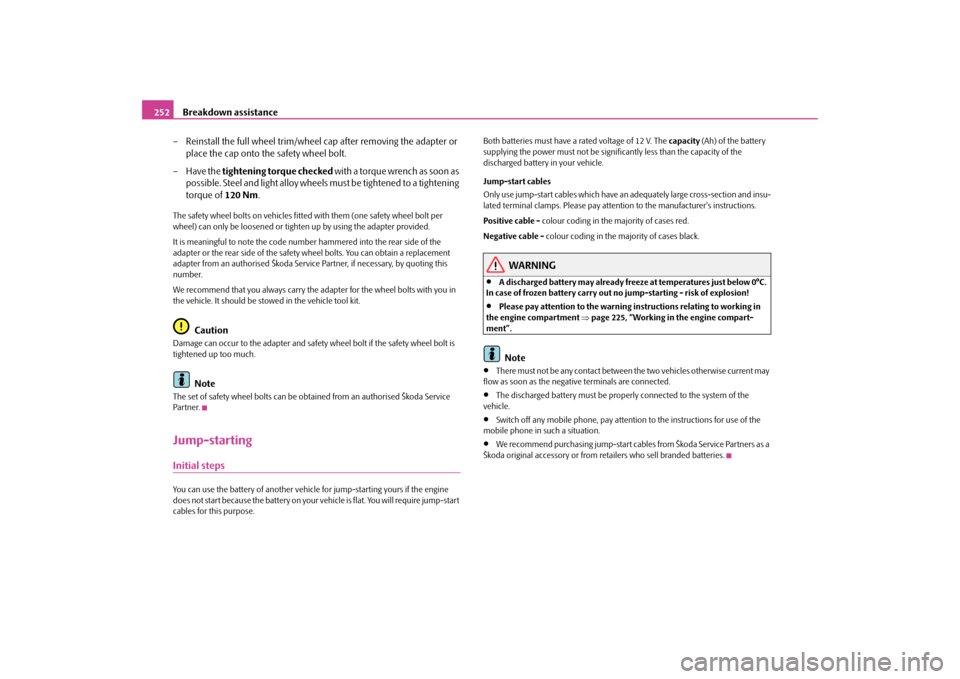
Breakdown assistance
252
– Reinstall the full wheel trim/wheel cap after removing the adapter or
place the cap onto the safety wheel bolt.
– Have the
tightening torque
checked
w i t h a t o rq u e w re n c h a s s o o n a s
possible. Steel and light alloy wheels must be tightened to a tightening torque of
120 Nm
.
The safety wheel bolts on vehicles fitted with them (one safety wheel bolt per wheel) can only be loosened or tigh
ten up by using the adapter provided.
It is meaningful to note the code numbe
r hammered into the rear side of the
adapter or the rear side of the safety wheel bolts. You can obtain a replacement adapter from an authorised Škoda Service Partner, if necessary, by quoting this number. We recommend that you always carry the
adapter for the wheel bolts with you in
the vehicle. It should be st
owed in the vehicle tool kit.
Caution
Damage can occur to the adapter and safety
wheel bolt if the safety wheel bolt is
tightened up too much.
Note
The set of safety wheel bolts can be obta
ined from an authorised Škoda Service
Par tner.Jump-startingInitial stepsYou can use the battery of another vehicl
e for jump-starting yours if the engine
does not start because the battery on your
vehicle is flat. You will require jump-start
cables for this purpose.
Both batteries must have a rated voltage of 12 V. The
capacity
(Ah) of the battery
supplying the power must not be signific
antly less than the capacity of the
discharged battery
in your vehicle.
Jump-start cables Only use jump-start cables which have an
adequately large cross-section and insu-
lated terminal clamps. Please pay attent
ion to the manufacturer's instructions.
Positive cable -
colour coding in the
majority of cases red.
Negative cable -
colour coding in the majority of cases black.
WARNING
•
A discharged battery may already freeze
at temperatures just below 0°C.
In case of frozen battery carry out no jump-starting - risk of explosion!•
Please pay attention to the warning instructions relating to working in
the engine compartment
⇒page 225, “Working in the engine compart-
ment”.
Note
•
There must not be any contact between the two vehicles otherwise current may
flow as soon as the negative terminals are connected.•
The discharged battery must be proper
ly connected to the system of the
vehicle.•
Switch off any mobile phone, pay attent
ion to the instructions for use of the
mobile phone in such a situation.•
We recommend purchasing jump-start cabl
es from Škoda Service Partners as a
Škoda original accessory or from retailers who sell branded batteries.
se0.1.book Page 252 Frida
y, April 10, 2009 3:19 PM